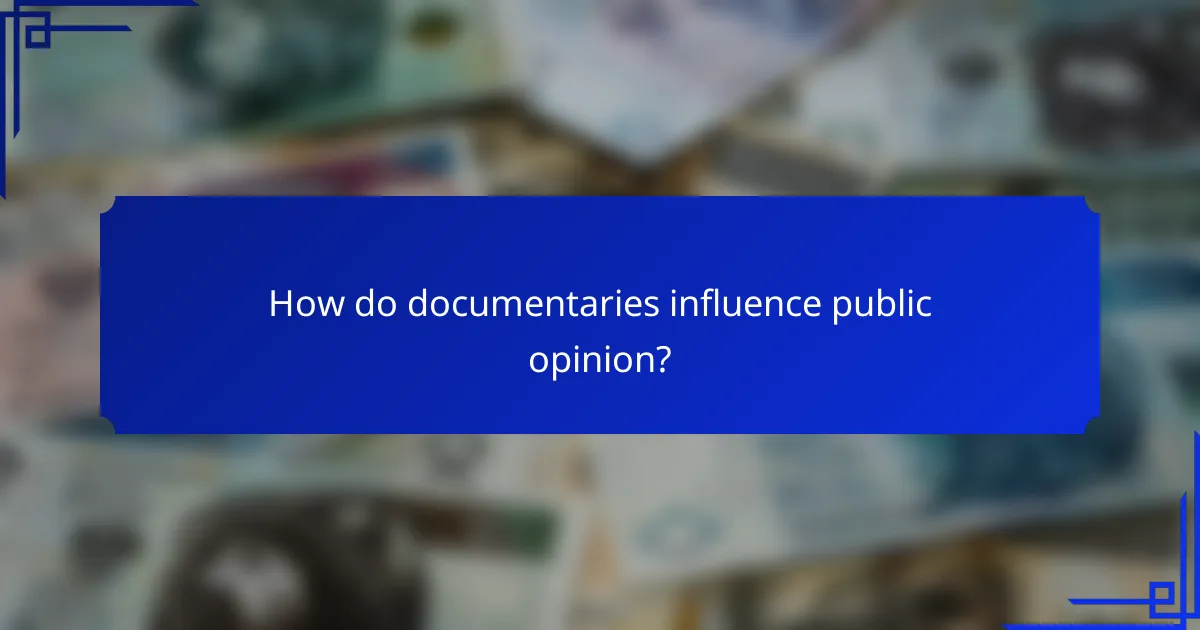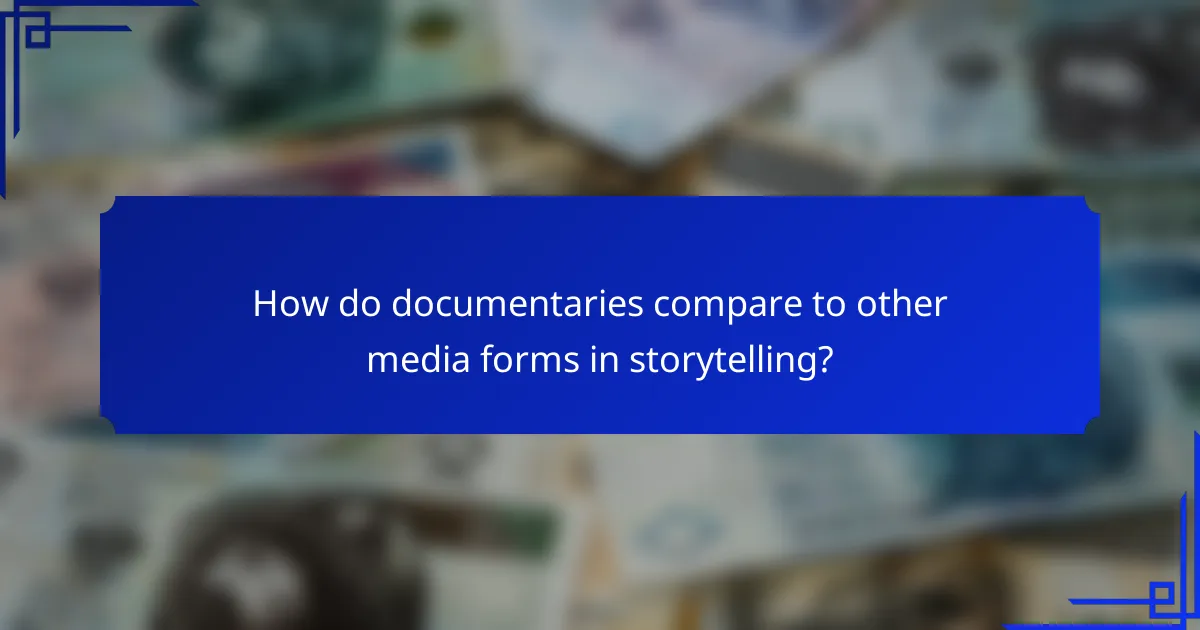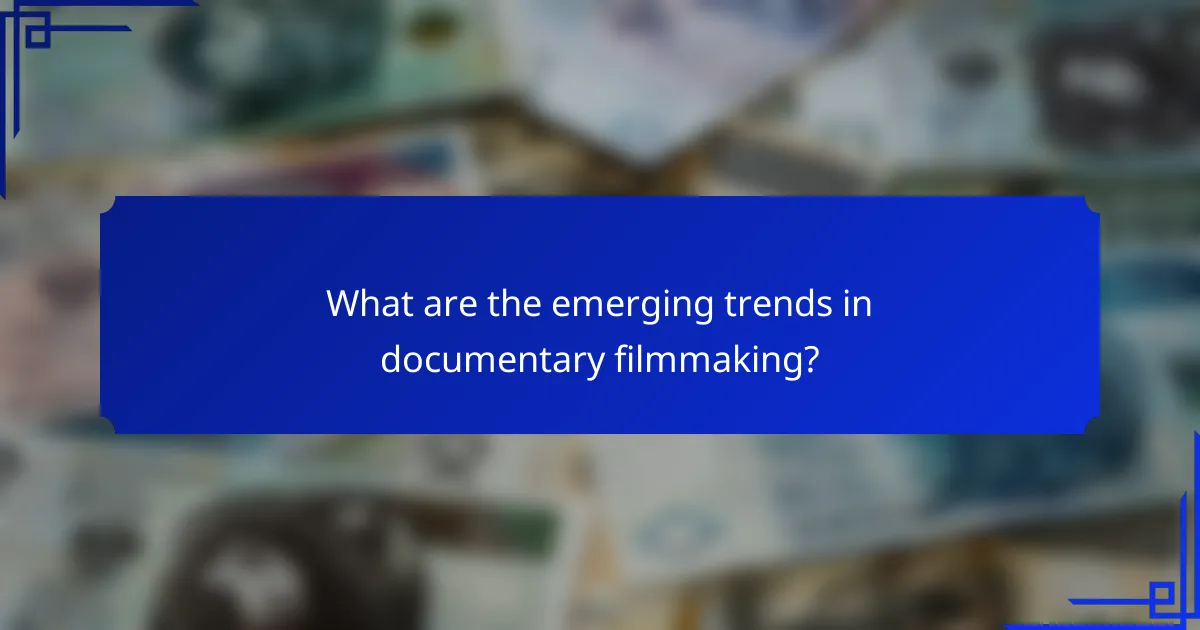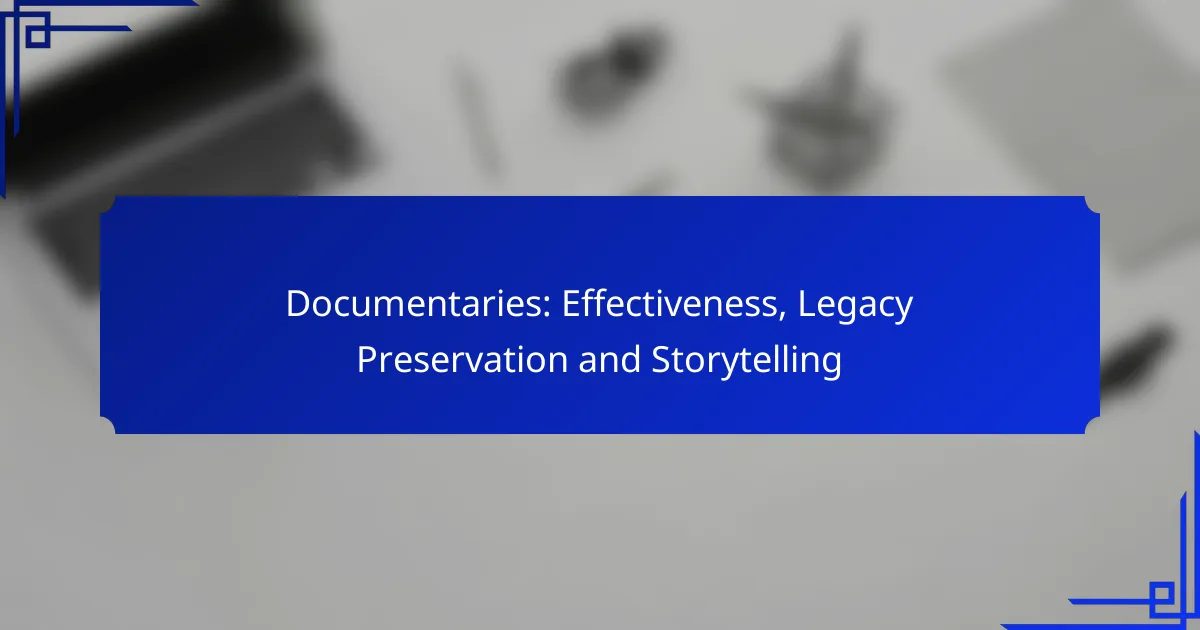Documentaries serve as vital tools for preserving legacy by capturing historical events, cultural narratives, and personal stories, ensuring that important moments are remembered. Through effective storytelling techniques, they engage audiences emotionally and intellectually, shaping public opinion and inspiring action on critical issues.

How do documentaries preserve legacy in the United States?
Documentaries play a crucial role in preserving legacy in the United States by capturing and presenting historical events, cultural narratives, and personal stories. They serve as a medium for education and reflection, ensuring that significant moments and voices are not forgotten over time.
Historical documentation
Documentaries provide a visual and auditory record of historical events, often featuring interviews with eyewitnesses and experts. By presenting archival footage and photographs, they create a compelling narrative that helps viewers understand the context and impact of these events. For instance, documentaries about the Civil Rights Movement often include firsthand accounts and historical footage, making the past more accessible and relatable.
These films can also highlight lesser-known events, ensuring that diverse perspectives are included in the historical narrative. This approach not only informs but also engages audiences, prompting discussions about the implications of history on contemporary society.
Cultural representation
Documentaries serve as a platform for cultural representation, showcasing the traditions, struggles, and achievements of various communities. They highlight the richness of American culture by focusing on different ethnicities, lifestyles, and art forms, thus fostering a greater understanding and appreciation among viewers. For example, documentaries exploring Native American culture often delve into their history, art, and ongoing challenges, providing a voice to communities that have been marginalized.
By portraying authentic stories and experiences, these films can challenge stereotypes and promote empathy, encouraging audiences to engage with cultures outside their own. This representation is vital for preserving the legacies of diverse groups within the United States.
Personal narratives
Personal narratives in documentaries allow individuals to share their unique stories, contributing to the broader tapestry of American life. These films often focus on personal experiences related to significant social issues, such as immigration, mental health, or family dynamics. By presenting these intimate accounts, documentaries humanize complex topics and foster a deeper connection with viewers.
Moreover, personal narratives can inspire others by showcasing resilience and the human spirit. Documentaries that feature individuals overcoming adversity or pursuing their passions can motivate audiences to reflect on their own lives and challenges, reinforcing the idea that every story matters in the preservation of legacy.

What are the most effective storytelling techniques in documentaries?
Effective storytelling techniques in documentaries include character-driven narratives, visual storytelling, and emotional engagement. These methods help convey complex ideas and evoke responses from the audience, enhancing the overall impact of the documentary.
Character-driven narratives
Character-driven narratives focus on individuals whose experiences embody the larger themes of the documentary. By highlighting personal stories, filmmakers create relatable connections that draw viewers in and make the subject matter more accessible.
To develop strong character-driven narratives, it’s essential to choose subjects with compelling backgrounds and motivations. This approach often involves in-depth interviews and a focus on the character’s journey, which can resonate with audiences on a personal level.
Visual storytelling
Visual storytelling uses imagery to convey messages and emotions without relying solely on dialogue. This technique can include striking cinematography, symbolic imagery, and creative editing to enhance the narrative and maintain viewer interest.
Incorporating diverse visual elements—such as archival footage, animations, or infographics—can enrich the storytelling experience. Filmmakers should aim for a balance between visuals and audio to create a cohesive narrative that captivates the audience.
Emotional engagement
Emotional engagement is crucial for making documentaries memorable and impactful. By evoking feelings such as empathy, sadness, or inspiration, filmmakers can create a lasting impression on viewers.
To foster emotional engagement, consider using music, personal testimonies, and relatable situations that resonate with the audience. Avoiding overly sensationalized content can help maintain authenticity and strengthen the emotional connection with viewers.

How do documentaries influence public opinion?
Documentaries significantly shape public opinion by presenting information in a compelling narrative format. They can alter perceptions, raise awareness about critical issues, and motivate viewers to take action.
Shaping perceptions
Documentaries influence how audiences perceive various topics by framing narratives in specific ways. For instance, a documentary focusing on environmental issues may highlight the urgency of climate change, leading viewers to view it as a pressing concern. This framing can create a lasting impact on how individuals understand and relate to these issues.
Moreover, the storytelling techniques used in documentaries, such as personal testimonies and visual imagery, can evoke emotional responses that further solidify these perceptions. By humanizing complex subjects, documentaries make them more relatable and easier to comprehend.
Raising awareness
Documentaries serve as powerful tools for raising awareness about social, political, and environmental issues that may otherwise go unnoticed. They often bring attention to marginalized voices and underreported stories, effectively educating the public on critical matters. For example, a documentary on poverty may reveal the systemic factors contributing to economic disparity, prompting viewers to reconsider their understanding of the issue.
Additionally, documentaries can highlight the importance of specific movements or events, encouraging viewers to engage with these topics on a deeper level. This increased awareness can lead to more informed discussions and a broader understanding of societal challenges.
Encouraging action
Many documentaries aim not just to inform but also to inspire action among viewers. By showcasing the impact of individual or collective efforts, they motivate audiences to participate in advocacy, volunteer work, or charitable giving. For instance, a documentary about wildlife conservation may encourage viewers to support relevant organizations or adopt sustainable practices.
To effectively encourage action, documentaries often provide clear calls to action, such as links to petitions or resources for further involvement. Viewers are more likely to act when they feel empowered and equipped with the necessary information to make a difference.

What criteria should you consider when selecting a documentary for viewing?
When selecting a documentary, consider the director’s reputation, the relevance of the subject matter, and the film’s critical acclaim. These factors can significantly impact your viewing experience and the documentary’s overall quality.
Director’s reputation
The director’s reputation can greatly influence the quality and perspective of a documentary. Established directors often have a track record of producing compelling and well-researched films, which can enhance your viewing experience.
Look for directors who have received awards or recognition in the documentary field. For instance, a director known for impactful social issue documentaries may provide a more nuanced and engaging portrayal of their subject.
Subject matter relevance
Consider how relevant the documentary’s subject matter is to your interests or current events. Documentaries that tackle timely issues or topics you are passionate about can be more engaging and informative.
For example, if you are interested in climate change, selecting a documentary that focuses on environmental issues will likely resonate more with you than one on a less relevant topic. This alignment can enhance your understanding and connection to the material.
Critical acclaim
Critical acclaim is another important criterion when selecting a documentary. Reviews from reputable sources can provide insights into the film’s quality, storytelling, and overall impact.
Check platforms like Rotten Tomatoes or Metacritic for ratings and reviews. A documentary with high ratings and positive feedback from critics is often a safer bet for a rewarding viewing experience.

How do documentaries compare to other media forms in storytelling?
Documentaries excel in storytelling by providing in-depth exploration of real-life subjects, often presenting facts and narratives that other media forms may gloss over. Their unique format allows for a combination of visual elements, interviews, and expert commentary, creating a comprehensive understanding of complex issues.
Depth of content
Documentaries typically offer a greater depth of content compared to other media forms like films or television shows. They delve into subjects with extensive research, interviews, and firsthand accounts, allowing viewers to gain a nuanced perspective. For instance, a documentary on climate change may include scientific data, personal stories from affected individuals, and expert insights, providing a holistic view of the issue.
This depth is particularly valuable for educational purposes, as documentaries can serve as rich resources for students and researchers. They often explore topics in a way that encourages critical thinking and fosters a deeper understanding of societal issues.
Viewer engagement
Viewer engagement in documentaries often stems from their ability to tell compelling stories that resonate emotionally. Unlike traditional news reports, documentaries can create a narrative arc that captivates audiences, drawing them into the subject matter. For example, a documentary about a social movement may follow key figures, showcasing their struggles and triumphs, which can evoke empathy and inspire action.
Factual accuracy
Factual accuracy is a hallmark of documentaries, as they often rely on thorough research and credible sources to present information. Many documentaries adhere to journalistic standards, ensuring that the facts presented are verified and reliable. This commitment to accuracy distinguishes them from fictional media, where creative liberties may distort reality.

What are the emerging trends in documentary filmmaking?
Emerging trends in documentary filmmaking include interactive formats and the growing influence of streaming platforms. These developments are reshaping how stories are told and consumed, making documentaries more engaging and accessible to diverse audiences.
Interactive documentaries
Interactive documentaries allow viewers to engage with content in a non-linear fashion, often through clickable elements or immersive experiences. This format encourages active participation, enabling audiences to explore topics at their own pace and from various perspectives.
For instance, platforms like interactive-documentary.com showcase projects that blend traditional storytelling with user-driven exploration. This trend can enhance emotional connections and deepen understanding of complex issues.
Streaming platforms’ influence
Streaming platforms have significantly impacted documentary filmmaking by providing wider distribution channels and access to global audiences. Services like Netflix and Amazon Prime Video have invested heavily in original documentary content, increasing visibility and funding for filmmakers.
As a result, documentaries are now more mainstream, often competing with scripted content for viewer attention. Filmmakers should consider the unique requirements of these platforms, such as audience engagement metrics and the importance of captivating openings to retain viewers.
